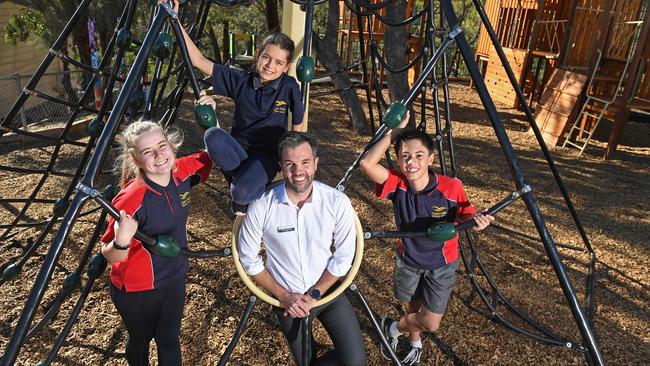NAPLAN tables: The SA schools that get an A for improvement
SA’s education chief says sustained improvement is more important than raw NAPLAN scores, so we’re celebrating nine schools with a strong trajectory of growth. Explore our searchable database to see how your school compares.
Schools Hub
Don't miss out on the headlines from Schools Hub. Followed categories will be added to My News.
From Salisbury to Seaford, there are schools across South Australia thriving under a controversial data-driven rating system, the state Education Department says.
After spending nearly $1 million on consultants, the department in 2018 launched its “stages of improvement” system, rating every public school, largely on NAPLAN and SACE results, and placing them on a five-level improvement scale.
As well as raw scores, it measures “trajectory” of improvement, or otherwise, over time, recognising schools in lower socio-economic areas with middling raw scores might be big improvers, while schools in wealthier areas with high scores could be coasting.
But a UniSA study last month revealed some principals in poorer areas felt the system was biased against their schools.
The department does not make public the results of the ratings for all schools, which also covers student wellbeing data, but has supplied a sample of big improvers.
SCROLL DOWN TO SEARCH NAPLAN RESULTS FOR EVERY SA SCHOOL
An overview of schools in 2017 pointed to a “patchiness” across the state, Education Department chief executive Rick Persse said.
“We didn’t want to tolerate that in the long run and we thought we could make some really big interventions to address that,” he said.
“SA wasn’t where we should be on NAPLAN (as one of the measures).
“And despite the wishes of politicians and parents you can’t fix something like the state’s NAPLAN results overnight.”
Much of the Education Department’s focus had been toward schools in the middle of the pack, which left some schools coasting and others struggling.
Working with consultants McKinsey, a five-tier ranking system was developed using a range of measures including NAPLAN data, SACE data and student wellbeing.
This placed schools on a rank, in ascending order, “build foundations”, “maintain momentum”, “shift gear”, “stretch”, and “inspire”.
Every school was instructed to create a school improvement plan with literacy and numeracy as priorities.
Eden Hills Primary School is one of the schools taking advantage of the more formally structured approach to assessment and strategy.
Its plan sets out specific goals with measurable targets, including annual increases in the proportion of students achieving NAPLAN results to certain levels.
“In the past three years, we’ve gone up into the ‘inspire’ category,” Eden Hills principal Andrew Dowling said.
“We’re very proud of that, it’s been a long journey of building a culture of high expectations and creating strong teacher efficacy and student well being.
“It’s about creating synchronicity between all the elements to create a strong teaching and learning environment.
“Unless the students are in a really good space physically and mentally, you’re not going to get the results.”

NAPLAN – the National Assessment Program Literacy and Numeracy – tests students in years 3, 5, 7 and 9.
The student cohort at Eden Hills who were in year 3 in 2017 and year 5 in 2019 improved at a faster rate than those in similar schools nationwide in reading, while those moving from year 5 to 7 improved faster than peers in reading and numeracy.
Mr Persse said improvement needed to be slow but steady.
“You don’t get to jump the shark,” he said.
“You can’t jump from stage one to stage five in one fell swoop, it’s impossible. You actually have to build incrementally through a mature strategy.
“We know it takes a great principal, fantastic teachers, engaged parents and carers, quality teaching support, money and infrastructure – we know what the ingredients are but you apply them differently depending on where that school is at on its journey.
“Let’s focus on the improvement. You can be a school that started at a perfectly acceptable NAPLAN level in terms of the Australian average but then don’t improve at all – that’s a coasting school.
“What I’m interested in is the school that is improving and getting more growth into those kids, getting better SACE results, getting better SACE completion results.
“We want kids to have the most options. My measure is growth.”
Mr Persse urged parents to consider where their child was at before considering which school might be best for them.
“Enrolling your child who, say, hasn’t has a great foundation in their early years – wasn’t read to, wasn’t sung to, hadn’t heard a million words by the age of three – into a school which historically has had good NAPLAN results is not a guarantee,” he said.
“Some of the biggest growth that’s going on in SA is happening in schools that might not compare against a North Shore Sydney private primary school.
“It’s a misnomer to think that just because that school has historically had good NAPLAN results that your child will have good NAPLAN results.”
